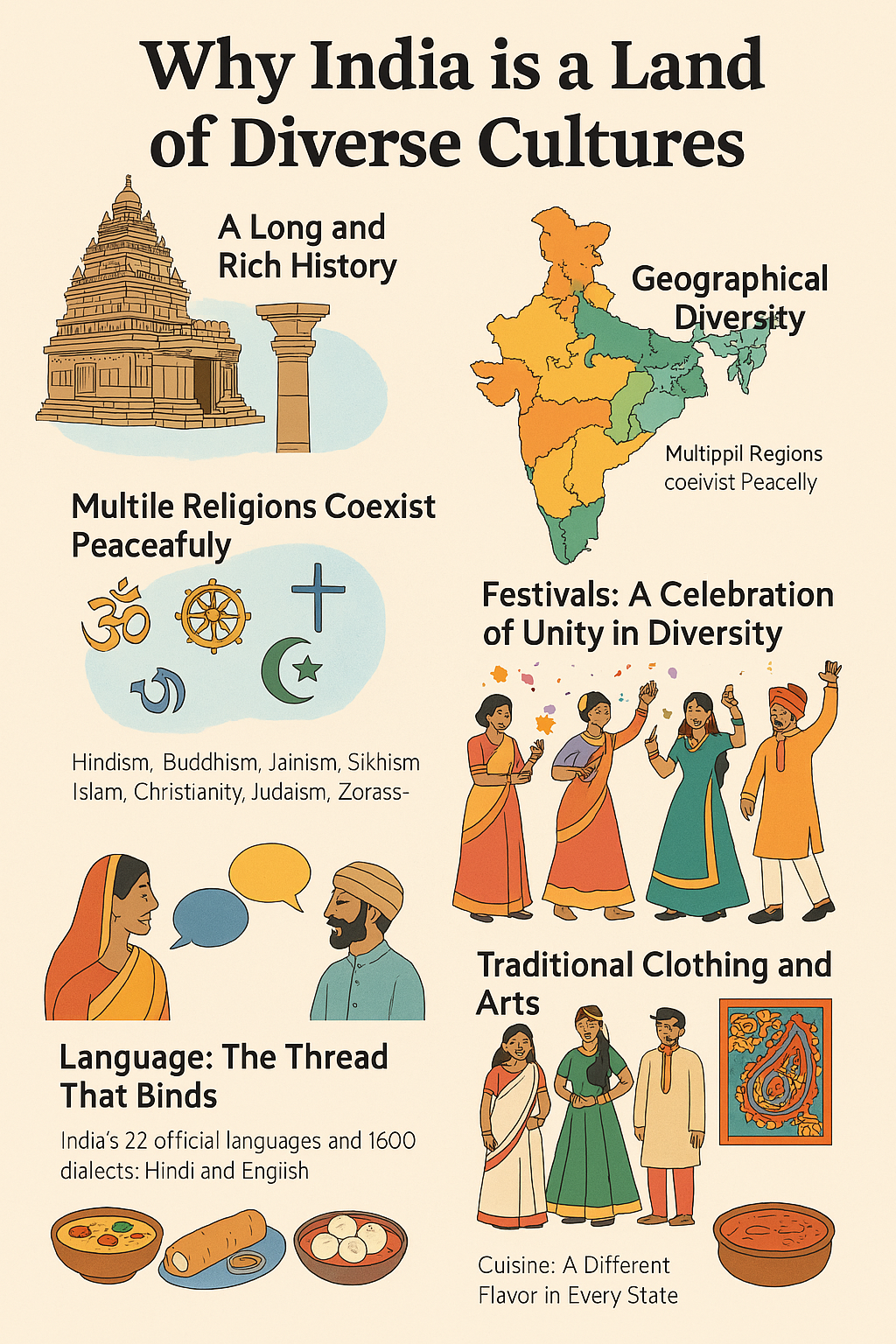India is often called a “subcontinent within a continent”, and for a good reason. It is home to over 1.4 billion people, speaking more than 1,600 languages, practicing multiple religions, and following countless traditions. The cultural diversity in India is unparalleled, making it one of the most unique and vibrant nations in the world. But what makes India so diverse? Let’s explore the reasons behind India’s rich cultural tapestry.
1. A Long and Rich History
India’s history dates back over 5,000 years, with civilizations such as the Indus Valley flourishing as early as 2500 BCE. Over the centuries, India has been influenced by Aryans, Mauryas, Guptas, Mughals, Britishers, and many more, each leaving their mark on language, architecture, food, and traditions. These interactions have created a fusion of cultures that coexist today.
2. Geographical Diversity
From the snow-capped Himalayas in the north to the tropical beaches in the south, India’s geography is incredibly varied. This influences the way people live, eat, and celebrate.
• North India: Influenced by Persian and Mughal culture, known for its rich gravies, grand architecture (Taj Mahal), and classical dance forms like Kathak.
• South India: Known for Dravidian heritage, ancient temples, spicy food, and classical dances like Bharatanatyam.
• East India: Rich in tribal traditions, famous for Durga Puja, and known for delicacies like Rasgulla.
• West India: Home to vibrant folk music, desert landscapes, and grand festivals like Navratri in Gujarat and Ganesh Chaturthi in Maharashtra.
Each region has developed distinct languages, attire, customs, and cuisines, making India a country with mini-countries within it.
3. Multiple Religions Coexist Peacefully
India is the birthplace of four major religions: Hinduism, Buddhism, Jainism, and Sikhism, while also being home to Islam, Christianity, Judaism, Zoroastrianism, and many tribal faiths. Religious diversity is seen in the numerous temples, mosques, churches, and gurudwaras across the country.
• The Kumbh Mela, the world’s largest religious gathering, is a Hindu pilgrimage.
• Eid, Christmas, Diwali, Holi, and Guru Nanak Jayanti are all widely celebrated, showcasing the spirit of unity.
4. Festivals: A Celebration of Unity in Diversity
Every day in India, you’ll find a festival being celebrated somewhere! Some are religious, while others are cultural.
• Holi (Festival of Colors) brings together people of all backgrounds.
• Diwali (Festival of Lights) is celebrated by Hindus, Sikhs, Jains, and Buddhists alike.
• Onam in Kerala, Bihu in Assam, and Pongal in Tamil Nadu reflect regional traditions.
• Republic Day and Independence Day unite the nation beyond religion and region.
Festivals in India are not just about religion but also about food, dance, music, and togetherness, creating a bond between diverse communities.
5. Language: The Thread That Binds
India has 22 officially recognized languages and over 1,600 dialects! While Hindi is widely spoken, regional languages like Tamil, Bengali, Telugu, Marathi, and Punjabi have their own rich literature and cinema industries. Despite the differences, English and Hindi often act as a linking language, allowing people from different regions to communicate.
6. Traditional Clothing and Arts
India’s diversity is reflected in its attire and craftsmanship:
• Saris, Salwar Kameez, and Lehenga-Cholis in different styles across regions.
• Men wear Dhoti, Kurta-Pajamas, and Sherwanis in varied designs.
• Handicrafts like Madhubani paintings, Phulkari embroidery, Pashmina shawls, and Banarasi silk sarees are unique to each state.
Each piece of clothing or artwork tells a story of the region’s history, climate, and cultural influences.
7. Cuisine: A Different Flavor in Every State
Indian food is as diverse as its people.
• North Indian food is rich in dairy, wheat-based bread (roti, naan), and flavorful curries.
• South Indian cuisine is centered around rice, coconut, and dishes like dosa, idli, and sambar.
• East India is known for sweets like Rasgulla and spicy fish curries.
• West India has spicy Rajasthani food, Goan seafood, and Mumbai’s street snacks.
Food habits vary not just by region but also by religion, climate, and local ingredients available.
8. Digital Age and Unity Through Gaming
Technology has become a new way of connecting diverse cultures in India. Online platforms, social media, and gaming communities are bringing people from different backgrounds together in an interactive way.
One such example is Flutter Bees, a play-to-earn game that unites players from across India and beyond. It provides a fun and engaging environment where people from different cultures can collaborate, compete, and earn rewards while playing. Whether you’re from Punjab, Tamil Nadu, Gujarat, or Assam, you can build your farm, collect honey, and interact with other players, fostering unity in a virtual space.
Join the Flutter Bees Network and experience a new way to connect, play, and grow together: Play Now
Conclusion: India’s Unity in Diversity
India’s diversity is not just about differences but about coexistence. Despite various cultures, languages, and religions, there is a sense of “Indianness” that binds people together. The phrase “Unity in Diversity” perfectly describes how India thrives with respect, acceptance, and harmony among its diverse communities.
Whether you’re exploring ancient temples, enjoying a festival, or even playing a digital game like Flutter Bees, India is a celebration of diversity in every way. That’s what makes it one of the most fascinating and colorful countries in the world!
What’s your favorite aspect of India’s cultural diversity? Let us know in the comments!
